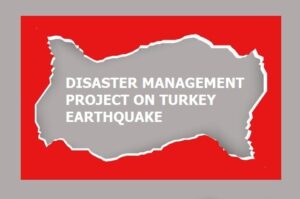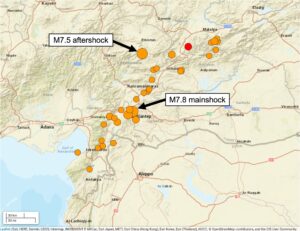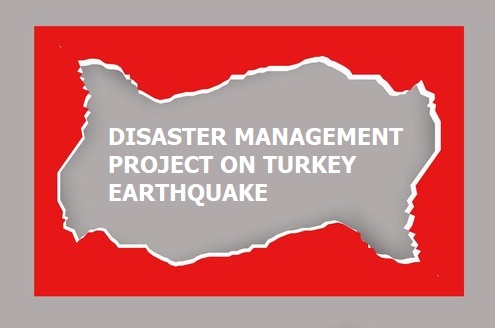Step By Step Guide On Your Project On Turkey Earthquake
Project on Turkey Earthquake is most probably going to be the topic of your Disaster Management Project. Every year, class 9 students must complete a project on disaster management. The CBSE mandates that class IX pupils turn in a handwritten project on disaster management. The school will supply the topics. Natural disasters or man-made disasters could be the subject. Giving class 9 children this disaster management assignment has as its goal of preparing them for any disaster. Moreover, the purpose of writing a project on Turkey’s earthquake is to Reduce the risk of disasters caused by human error, deliberate destruction, and building or equipment failures. Be better prepared to recover from a major natural catastrophe. Therefore, tighten your safety belts and get ready to complete your Disaster Management project on the Turkey earthquake.
Additionally, they can educate the populace on the safety measures that should be performed in the event of local or national disasters.
Project On Turkey Earthquake: A NATURAL DISASTER
A natural disaster is a sudden event that causes widespread damage, loss of life, or environmental harm.
Some common examples of natural disasters include earthquakes, hurricanes, floods, and wildfires.
These events can have a profound impact on communities, infrastructure, and the environment, and can take many years to recover from.
Understanding the causes, effects, and potential responses to natural disasters is crucial for reducing the harm they cause and improving
disaster resilience.
POINTS TO BE INCLUDED IN YOUR PROJECT ON TURKEY EARTHQUAKE

SOCIAL SCIENCE PROJECT ON TURKEY EARTHQUAKE
Here are the steps to writing a disaster management project on earthquakes:
Introduction:
Briefly explain the importance of disaster management, especially in the context of earthquakes, and provide a background of the topic.
Problem statement:
Discuss the negative impact of earthquakes and the need for disaster management in response to this type of natural disaster.
Literature review:
Conduct research on previous efforts to manage earthquakes and summarize the findings.
Methodology:
Explain the approach you plan to take in your project, including the research methods, data collection, and analysis techniques.
Case studies:
Present examples of successful disaster management in response to earthquakes in different parts of the world.
Risk assessment:
Evaluate the likelihood of earthquakes in a specific region and the potential impact on the population and infrastructure.
Planning and preparation:
Discuss the steps that can be taken before an earthquake occurs to minimize its impacts, such as creating early warning systems, emergency preparedness plans, and evacuation routes.
Response and recovery:
Describe the actions that should be taken immediately after an earthquake, including search and rescue operations, emergency medical services, and providing temporary housing and basic necessities.
Conclusion:
Summarize the findings of your project and provide recommendations for future disaster management efforts in response to earthquakes.
References:
List the sources you used in your project, including books, journal articles, and websites, following a standard referencing style.
Step By Step Guide On Your Project On Turkey Earthquake

PROJECT ON TURKEY EARTHQUAKE
INTRODUCTION:
On January 24, 2022, and on February 06, 2023, an earthquake with a magnitude of 6.2 & 7.8 respectively struck the province of Elazig in
Eastern Turkey.
The quake resulted in the loss of lives and caused widespread damage to buildings and infrastructure in the affected areas.
Rescue and relief efforts were immediately launched by the government and various aid organizations to help those affected by the disaster.
PROBLEM STATEMENT:
The earthquake in eastern Turkey resulted in a number of significant problems, including loss of life, physical injuries, displacement of
residents, and damage to homes and infrastructure.
The disaster caused widespread panic and fear among the local population, and the already strained healthcare system was overwhelmed by
a large number of injured individuals.
In addition, the damage to buildings, roads, and bridges made rescue and relief efforts more difficult and created obstacles to aid
organizations seeking to bring supplies and support to the affected communities.
The earthquake also caused economic disruption in the region, with businesses and industries being temporarily shut down or severely
impacted, leading to the loss of livelihoods and income for many people.
These problems have combined to create a complex and challenging situation for the people and authorities in eastern Turkey,
and a sustained response will be necessary to fully address the aftermath of the disaster.
A LITERATURE REVIEW ON THE EARTHQUAKE
A literature review on the earthquake in Turkey would involve an examination of existing research and studies on the topic.
This could include an analysis of the causes and factors that led to the earthquake, the impact it had on the affected region, and the
measures are taken to mitigate its effects.
Some of the key findings from previous research on the topic might include information on the tectonic activity in the region and the
geological conditions that led to the earthquake.
Other studies could focus on the economic and social impact of the earthquake, including the destruction of infrastructure and housing,
and the displacement of populations.
Additionally, a literature review would likely explore the response of the government and other organizations to the earthquake, including
their efforts to provide relief and support to affected communities.
This could also involve a critical evaluation of the effectiveness of these efforts and an assessment of the challenges that were encountered
during the response process.
DATA COLLECTION AND ANALYSIS TECHNIQUES

Data collection and analysis on the Turkey earthquake would involve gathering and analyzing relevant data and information on the event.
This could include:
Seismological data
This would include information on the magnitude, location, and depth of the earthquake, as well as the pattern of seismic waves.
Damage assessment data
This could include information on the extent of damage to buildings, infrastructure, and other assets, as well as the number of casualties and
displaced people.
Demographic data
This would involve collecting information on the population of the affected region, including age, gender, and socioeconomic status, which
could help to understand the impact of the earthquake on different groups.
Response and relief data
This would include information on the response of the government and other organizations to the earthquake, including the allocation of
resources and the provision of aid.
Once the data has been collected, it can be analyzed to gain insights and draw conclusions about the earthquake and its impact.
This could involve:
Statistical analysis
This could involve using statistical methods to analyze the data and identify patterns and trends.
GIS analysis
This could involve using geographical information systems (GIS) to map and analyze the distribution of damage, casualties, and other
effects of the earthquake.
Qualitative analysis
This could involve using qualitative methods, such as interviews and focus groups, to gain a deeper understanding of the experiences
and perspectives of those affected by the earthquake.
The findings from the data collection and analysis can be used to inform disaster response and recovery efforts, as well as to support future research on earthquakes and their impact.
CASE STUDIES
Successful disaster management in response to earthquakes in Turkey involves several key steps:
Early Warning Systems
Turkey has a well-developed early warning system that helps alert citizens to potential earthquakes.
This system uses advanced technology to detect earthquakes and provide timely warnings to the public.
Emergency Response Teams
The government has trained emergency response teams that are dispatched immediately after an earthquake to provide rescue and medical
assistance.
These teams are equipped with the necessary tools and resources to carry out their duties effectively.
Communication Systems
Communication systems, such as emergency hotlines and social media, are crucial in getting information out to the public quickly and
accurately during a disaster.
Turkey has a well-established communication infrastructure that helps keep the public informed and updated during a disaster.
Evacuation and Shelters
Effective evacuation plans and well-equipped shelters play a critical role in ensuring the safety of the public during an earthquake.
Turkey has established evacuation plans and provided adequate shelter for those affected by earthquakes.
Reconstruction and Recovery Efforts: After an earthquake, reconstruction, and recovery efforts are crucial in helping communities get back
on their feet.
The government, in collaboration with aid organizations, provides support for rebuilding homes and infrastructure, as well as offering
financial assistance and resources to those affected.
Overall, a combination of technology, planning, and effective coordination among various agencies is key to successful disaster management
in response to earthquakes in Turkey.
POTENTIAL IMPACT OF RISK ASSESSMENT

PROJECT ON TURKEY EARTHQUAKE
An earthquake in Turkey could potentially have significant impacts on both the population and infrastructure of the affected area.
The intensity of the earthquake and its location will determine the extent of the damage.
On the population side, the impact could range from loss of life and injury to displacement of people and destruction of homes and buildings.
Earthquakes can also cause widespread panic, fear, and mental trauma.
On the infrastructure side, the impact could range from damage to buildings and roads to disruption of power and communication systems,
to triggering of fires and landslides.
Depending on the magnitude and location of the earthquake, it could also impact transportation systems and other critical infrastructure.
Overall, earthquakes have the potential to cause widespread destruction and have far-reaching impacts on communities, economies, and
infrastructure.
PLANNING AND PREPARATION BEFORE AN EARTHQUAKE
To minimize the impact of an earthquake, the following steps can be taken:
Develop an emergency plan
Make a plan with your family or co-workers on what to do during an earthquake and how to evacuate safely.
Secure your home
Secure heavy objects, such as bookshelves, to walls and anchor tall furniture to prevent them from tipping over.
Stock up on supplies
Keep enough food, water, and medical supplies to last for at least three days.
Know the safe spots
Identify safe spots in every room, such as under a sturdy table or against an interior wall, and practice getting to them during drills.
Stay informed
Stay informed about earthquakes and related information from reliable sources, such as the US Geological Survey (USGS).
Take an earthquake preparedness class: Learn life-saving skills and how to make your home and workplace safer.
Remember, during an earthquake, the most important thing is to protect yourself.
Therefore, take cover under a sturdy object until the shaking stops.
STEPS TO BE TAKEN JUST AFTER AN EARTHQUAKE
The following actions should be taken immediately after an earthquake:
Protect yourself
If you are indoors, take cover under a desk or table and hold on to it until the shaking stops.
If you are outdoors, find a clear spot away from buildings, trees, and power lines.
Check for injuries
Check yourself and others for any injuries and provide first aid if necessary.
Evaluate the building
Check for any structural damage or hazards, such as broken glass, gas leaks, or fire.
If the building is damaged and unsafe, evacuate immediately.
Turn off gas and electricity
If you smell gas, turn off the main gas valve and evacuate the building.
If you see sparks or broken wires, turn off the electricity at the main breaker.
Evacuate if necessary
If you are in a damaged building or a coastal area that may be affected by a tsunami, evacuate immediately.
Stay tuned to local news
Listen to the radio or check local news sources for updates on the earthquake and any potential aftershocks or dangers.
Do not use elevators
Aftershocks can occur and can cause elevators to malfunction.
Use the stairs to evacuate.
Report any damages
If you have sustained any damages to your property, contact the appropriate authorities to report the damages.
CONCLUSION
In conclusion, earthquakes can cause significant damage and disruption to communities, and effective disaster management is essential for
minimizing their impact.
A comprehensive disaster management project for earthquakes in Turkey should include measures to increase preparedness and resilience,
such as public education and training programs, building code enforcement, and hazard mapping.
The project should also incorporate effective response and recovery strategies, such as establishing clear evacuation plans, identifying critical
infrastructure and resources, and setting up emergency communication systems.
Overall, a well-designed and well-executed disaster management project can help to ensure that communities are better prepared for
earthquakes, reducing the risk of harm to people and property and enabling a more efficient and effective response.
You may be interested in
Project On Tsunami: 13 Pages You Must Include In Your Disaster Management Project
11 Points You Must Include In Your Disaster Management Project On Climate Change





0 Comments